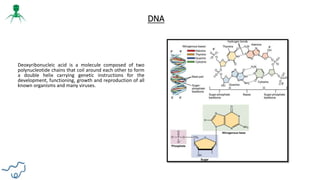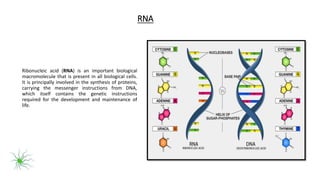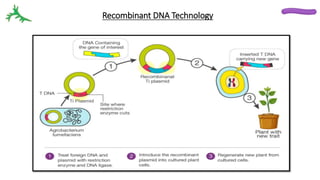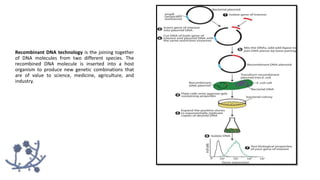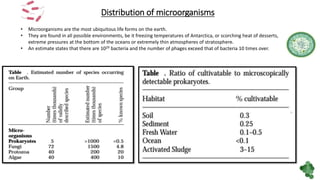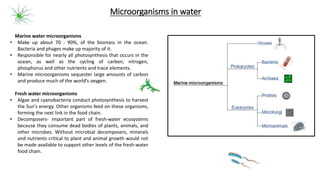Microbiology ppt
- 1. Environmental Microbiology Submitted by :- Himanshu Tiwari IDDP student 2021 January Batch Water Technology Management Division Submitted to :- Dr. Asifa Qureshi Principal Scientist EBGD Division
- 3. Freeze-drying ( Lyophilization ) • Freeze-drying is a process where water and other solvents are removed from a frozen product via sublimation. • Sublimation occurs when a frozen liquid goes directly to a gaseous state without entering a liquid phase. • It is recommended using slow rates of cooling, as this will result in the formation of vertical ice crystal structures, thus allowing for more efficient water sublimation from the frozen product Cryopreservation • Freezing in liquid nitrogen at -196 °C or in the gas phase above the liquid nitrogen at -150 °C • Cryopreservation helps survival of pure cultures for long storage times. • In this method, the microorganisms of culture are rapidly frozen in liquid nitrogen at -196°C in the presence of stabilizing agents such as glycerol or Dimethyl Sulfoxide (DMSO) that prevent the cell damage due to formation of ice crystals and promote cell survival. • This liquid nitrogen method has been successful with many species that cannot be preserved by lyophilization and most species can remain viable under these conditions for 10 to 30 years without undergoing change in their characteristics, however this method is expensive.
- 4. Periodic transfer to fresh media ( Sub culturing of active culture ) • Strains can be maintained by periodically preparing a fresh culture from the previous stock culture. • The culture medium, the storage temperature, and the time interval at which the transfers are made vary with the species and must be ascertained beforehand. • The temperature and the type of medium chosen should support a slow rather than a rapid rate of growth so that the time interval between transfers can be as long as possible. Saline Suspension • Sodium chloride in high concentration is frequently an inhibitor of bacterial growth. • Bacteria are suspended in 1% salt solution (sub lethal concentration in screw cap tubes to prevent evaporation). The tubes are stored at room temperature. Whenever needed the transfer is made on agar slant.
- 5. Oil overlay method • This is a simple and most economical method of maintaining pure cultures of bacteria and fungi. • In this method, sterile liquid paraffin is poured over the slant (slope) of culture and stored upright at room temperature. • The layer of paraffin ensures anaerobic conditions and prevents dehydration of the medium. Using water or buffer • Bacterial cells collected from rich agar media are transferred to sterile water or PBS (Phosphate buffered saline) at pH 7.2 . • The tubes are sealed with Para film membranes and stored in the dark and at room temperature or 4 0C. • A vast majority of bacteria survive well in water and in PBS for at least 30 weeks.
- 6. DNA Deoxyribonucleic acid is a molecule composed of two polynucleotide chains that coil around each other to form a double helix carrying genetic instructions for the development, functioning, growth and reproduction of all known organisms and many viruses.
- 7. Location of DNA and RNA
- 8. RNA Ribonucleic acid (RNA) is an important biological macromolecule that is present in all biological cells. It is principally involved in the synthesis of proteins, carrying the messenger instructions from DNA, which itself contains the genetic instructions required for the development and maintenance of life.
- 9. Replication of DNA • DNA replication is the process by which a double-stranded DNA molecule is copied to produce two identical DNA molecules. Replication is an essential process because, whenever a cell divides, the two new daughter cells must contain the same genetic information, or DNA, as the parent cell.
- 11. Recombinant DNA technology is the joining together of DNA molecules from two different species. The recombined DNA molecule is inserted into a host organism to produce new genetic combinations that are of value to science, medicine, agriculture, and industry.
- 12. Distribution of microorganisms • Microorganisms are the most ubiquitous life forms on the earth. • They are found in all possible environments, be it freezing temperatures of Antarctica, or scorching heat of desserts, extreme pressures at the bottom of the oceans or extremely thin atmospheres of stratosphere. • An estimate states that there are 1029 bacteria and the number of phages exceed that of bacteria 10 times over.
- 13. Microorganisms in soil • The number and kinds of microorganisms present in soil depend on the: Type of soil, Quantity of plant and animal humus acidity or alkalinity, Depth, Degree of aeration, Moisture contents, Temperature. • 1 g of soil typically contains 1 – 10 billion bacteria belonging to approx. 50-60,000 species. Of this more than 99% cannot be grown in laboratory. • The great majority of microorganisms are found in surface layer. • The number decrease with: Depth, Owing to lack Oxygen and food materials. • Microbes found in soil surrounding roots of plants, called rhizosphere, are of great importance as they promote plant growth promotion as perform other functions such as nitrogen fixation.
- 14. Microorganisms in Air • Microorganisms, found in air, do not grow and multiply because conditions are not favorable for their growth. • The abundance and diversity of microbes depend on: Location Moisture Dust particles, and Presence of toxic gases. • In general, marine air contains fewer microorganisms than dusty and desert air. • The air over higher mountains is usually free from organisms. • Dusty room usually show more organisms adhering to particles of dust than dust free room. Bioaerosols are everywhere in the environment. Some bioaerosols, when breathed in, can cause diseases such as pneumonia, asthma, rhinitis. Some bioaerosols can also infect the eyes and enter via ingestion.
- 15. Indoor air microbiology • Study of microorganisms present in indoor environment • Responsible for biodeterioation of storage materials, equipment, library materials and archives. • Survive for extended period in indoors as they have relatively less exposure to radiations. • Examples are: Penicillium Aspergillus Staphylococci Bacillus Clostridium Outdoor air microbiology • Study of microorganisms present in outdoor, such as outside the buildings • Composition and diversity of microorganisms may vary from place to place, depending upon the human population densities. • Examples are: Cladosporiul Sporobolomyces Aspergillus Alternaria Phytophthora
- 16. Marine water microorganisms • Make up about 70 - 90%, of the biomass in the ocean. Bacteria and phages make up majority of it. • Responsible for nearly all photosynthesis that occurs in the ocean, as well as the cycling of carbon, nitrogen, phosphorus and other nutrients and trace elements. • Marine microorganisms sequester large amounts of carbon and produce much of the world’s oxygen. Fresh water microorganisms • Algae and cyanobacteria conduct photosynthesis to harvest the Sun's energy. Other organisms feed on these organisms, forming the next link in the food chain. • Decomposers- important part of fresh-water ecosystems because they consume dead bodies of plants, animals, and other microbes. Without microbial decomposers, minerals and nutrients critical to plant and animal growth would not be made available to support other levels of the fresh-water food chain. Microorganisms in water
- 17. Thank you





